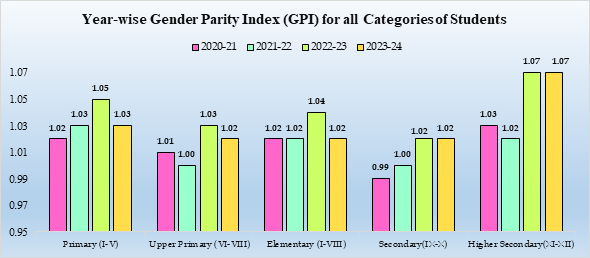Bridging the Gender Gap: Insights from “Women and Men in India 2024”

- 09 Apr 2025
In News:
The Ministry of Statistics and Programme Implementation (MoSPI) recently released the 26th edition of “Women and Men in India 2024: Selected Indicators and Data”, a flagship publication that offers a gender-disaggregated statistical portrait of India. This comprehensive document provides valuable insights into the progress, challenges, and opportunities in achieving gender equality across various socio-economic spheres.
Purpose and Scope
Drawing from official statistics across Ministries and Departments, the publication covers vital areas such as population dynamics, education, health, economic participation, and political representation, highlighting disparities and gains across gender lines. It also reflects urban-rural divides and regional variations, thus enabling data-driven policymaking for inclusive development.
Education: Moving Towards Gender Parity
India has shown consistent improvements in Gender Parity Index (GPI) in education. Primary and higher secondary levels have maintained high GPI values, indicating strong female enrolment rates. While upper primary and elementary levels witnessed some fluctuations, they largely remained close to parity, demonstrating the impact of initiatives like Beti Bachao, Beti Padhao and expanding access to girls’ education.
Labour Force and Financial Inclusion
Women’s Labour Force Participation Rate (LFPR) has seen a marked improvement, rising from 49.8% in 2017-18 to 60.1% in 2023-24 (usual status for ages 15+). This indicates a gradual integration of women into the formal and informal workforce, though structural and cultural barriers persist.
In the financial sector, women now own 39.2% of all bank accounts and contribute 39.7% of total deposits. Their participation is especially prominent in rural India, where they make up 42.2% of account holders, showcasing the success of financial inclusion efforts under the Pradhan Mantri Jan Dhan Yojana.
Digital and Entrepreneurial Engagement
A notable trend is the sharp rise in DEMAT accounts, suggesting increased retail participation in capital markets. From March 2021 to November 2024, the total DEMAT accounts quadrupled from 33.26 million to 143.02 million. While men still dominate in terms of numbers, female participation also grew fourfold, rising from 6.67 million to 27.71 million in this period.
Encouragingly, female-led proprietary establishments across sectors such as manufacturing, trade, and services have shown a rising trend over 2021–24, indicating growing entrepreneurial confidence.
Additionally, startups with at least one woman director recognized by DPIIT rose from 1,943 in 2017 to 17,405 in 2024, underscoring the rise of women in innovation and enterprise.
Political Participation and Electoral Empowerment
Electoral data reflects the deepening roots of women’s political empowerment. The number of total electors rose from 173.2 million in 1952 to 978 million in 2024, with increasing female voter registration. Female voter turnout, which was 67.2% in 2019, stood at 65.8% in 2024. Notably, the gender gap in voting has narrowed, with female turnout surpassing male turnout in 2024, signaling a positive shift in political engagement.
Conclusion
The “Women and Men in India 2024” report is more than a statistical compendium—it is a mirror to India’s gender realities. While progress is evident in domains like education, financial inclusion, and entrepreneurship, persistent gaps remain. For India to achieve true gender equity, these insights must inform targeted, data-driven policies that empower women across all sectors, making gender equality central to the nation’s development discourse.
